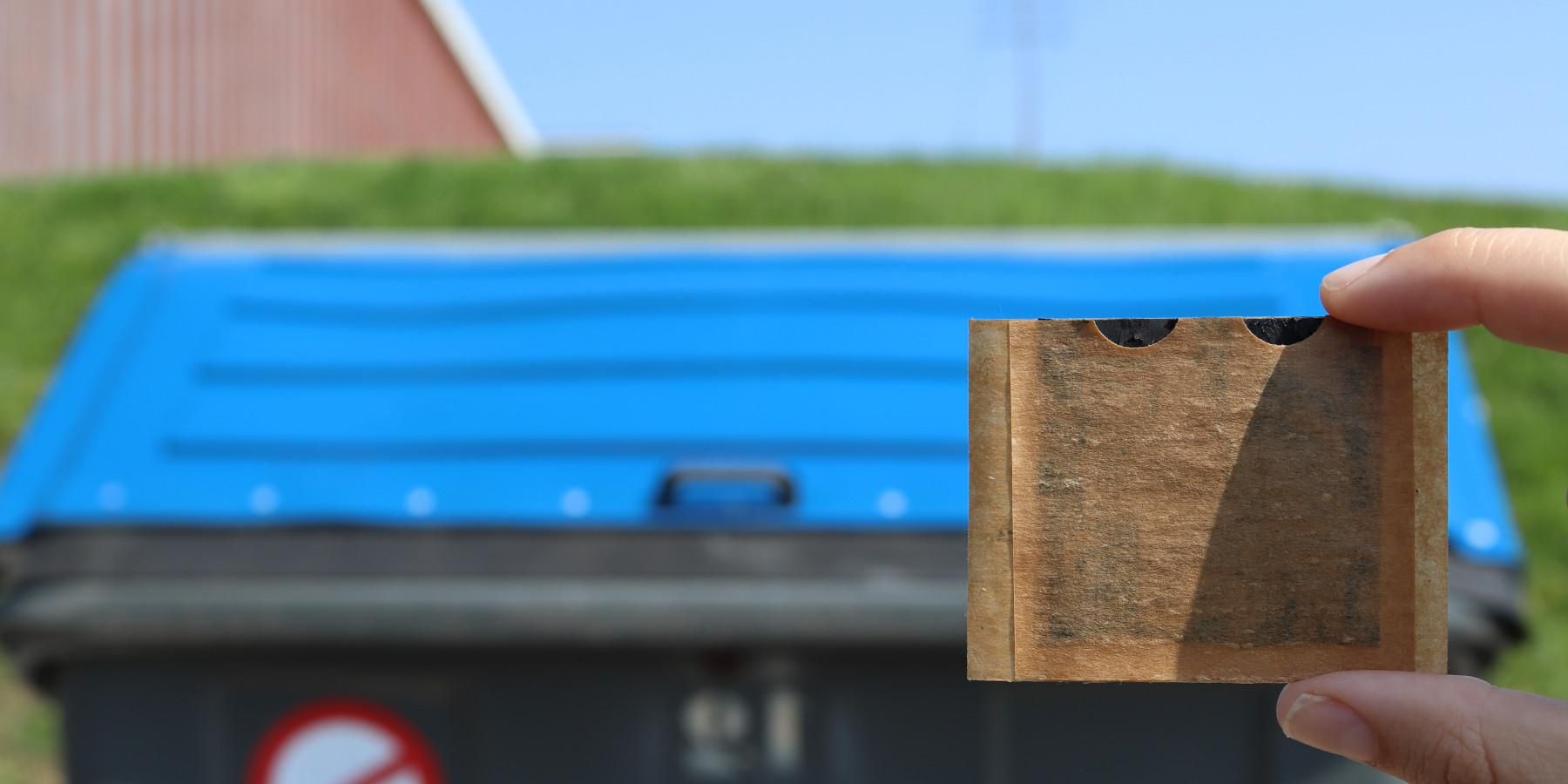Innovative methodology to ecodesign sustainable batteries that adapt to product life cycle
The conscious selection of materials and low-impact manufacturing techniques are key to facilitate end-of-life management and ensure the sustainability of the power source. A team from the Institute of Microelectronics of Barcelona (IMB-CNM-CSIC) and BCMaterials lays the foundations of this methodology through the design of a recyclable battery with paper and cardboard for smart packaging.

A hand holds the adhesive battery in front of a blue container for recycling paper and cardboard. Credit: Carles Tortosa y Marina Navarro.
A team from the CSIC's Institute of Microelectronics of Barcelona (IMB-CNM-CSIC) and the Basque Center for Materials, Applications and Nanostructures (BCMaterials) has developed a methodology for the eco-design of batteries adapted to the products they power. It consists of manufacturing energy sources taking into account the life cycle of the element, from the selection of materials to their recycling and final reuse, thus ensuring their circularity.
"We take into account what it will be used for and where it will end up in order to decide which materials and manufacturing techniques to use. The eco-design of the battery is done for a specific purpose and follows the life cycle of the application it powers," explains Juan Pablo Esquivel, IKERBASQUE researcher at BCMaterials, formerly at IMB-CNM-CSIC.
The scientific team has spent years perfecting the eco-design of batteries for different uses, such as the FlowER Battery in agriculture. Now, a recent publication in the journal Energy and Environmental Science extends the methodology and details the creation of a smart packaging battery made from lignocellulosic materials, including laser-induced graphene for the generation of the current collectors.
On the lookout for smart packaging
Electronics recycling is a growing issue in the digital society, and efforts to reduce waste start with its design. Button batteries are often the power source for the sensors that accompany packages sent by courier. Usually, neither the adhesive tape nor the tracking sensor can be recycled together with the packaging, which creates a conflict for recycling. Paper and cardboard have the highest recyclability rate among all materials, being around 74% in the European Union (2020) and allowing a high circularity of the fibers, which can be recycled up to 25 times. Therefore, smart packaging has been chosen as a high-impact scenario for the application of this methodology.On the other hand, EU data indicate that, of the 229 thousand tons of portable batteries sold in 2020, only 47% were collected for recycling. The aim of the new European regulation is to increase that figure to 73% over the next decade.
The publication's battery is a planar technology with a final format similar to a sticker that adheres to the packaging. In addition, "it has been demonstrated in standardized tests that it can be recycled in the blue paper and cardboard container without the need to separate it from the packaging," says Marina Navarro, a postdoctoral researcher at BCMaterials, formerly at IMB-CNM.
"The battery is versatile and can be manufactured with different sizes and voltages depending on the specific use to be given, it can work to power devices typically used in this sector, such as electrochromic displays or package tracking locators integrated to the Internet of Things and able to control parameters of the content, such as humidity and temperature," adds the scientist.
The substrate also includes a current collector made of laser-induced graphene (LIG) as a "sustainable alternative to the usual metals used in batteries due to its high electrical conductivity and chemical stability". If graphene were processed in other ways, such as in inks, "it would require more chemical reagents that we would then have to separate and eliminate in a higher energy consumption, which would result in a more polluting and less circular manufacturing", concludes Iñigo Martín, researcher at IMB-CNM-CSIC.
Eco-designed batteries for a sustainable future
The methodology presented offers a first guide to start ecodesigning power supplies, with the aim of making it a scalable technology in the future and reducing e-waste in the sector.
The work started with Navarro's thesis at IMB-CNM, supervised by Esquivel, and from a collaboration she initiated in Germany after receiving the PoLiS Cluster of Excellence award for young research personnel, funded by the German Foundation for Scientific Research (DFG). It includes the collaboration of Manuel Baumann and Marcel Weil from the Karlsruhe Institute of Technology; Marie Curie Fellow Omar Ibrahim and research assistant Carles Tortosa at the IMB-CNM spin-off Fuelium, co-founded by Esquivel; Martín's contribution to graphene technology; and the participation of IMB-CNM TFG student Joseba M. Ormaetxea.
Reference article: Marina Navarro-Segarra, Omar A. Ibrahim, Iñigo Martin-Fernandez, Carles Tortosa, Joseba M. Ormaetxea, Manuel Baumann, Marcel Weil and Juan Pablo Esquivel. Designed-by-purpose power sources: a cardboard primary battery for smart packaging. Energy and Environmental Science. DOI: 10.1039/D4EE00306C




